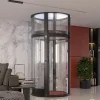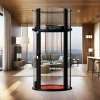The elevator industry is experiencing a significant transformation, driven by advancements in technology and increasing urbanization. As buildings become taller and smarter, the demand for efficient and innovative vertical transportation solutions is on the rise. Let’s explore the future trends and innovations that are shaping the elevator industry and revolutionizing vertical transportation.
- Smart Elevators
Smart elevators are becoming a cornerstone of modern buildings, integrating advanced technologies to enhance efficiency, safety, and user experience. These elevators use IoT (Internet of Things) sensors and AI (Artificial Intelligence) to optimize operations, predict maintenance needs, and provide real-time information to users and maintenance teams. Features like touchless controls, voice-activated commands, and personalized user experiences are making smart elevators a key trend in the industry.
- Sustainable and Energy-Efficient Elevators
With growing awareness of environmental issues, the elevator industry is focusing on sustainability and energy efficiency. Innovations such as regenerative drives, which capture and reuse energy, and energy-efficient LED lighting are becoming standard. Additionally, the use of lightweight materials and advanced engineering techniques reduces energy consumption and the environmental footprint of elevators. Elevator companies in the UAE and other regions are increasingly adopting these green technologies to meet stringent building standards and sustainability goals.
- Multi-Directional Elevators
Elevator industry, Traditional elevators move vertically between floors, but multi-directional elevators are set to revolutionize this concept. Technologies like the ropeless elevator system enable elevators to move both vertically and horizontally, offering greater flexibility and efficiency, especially in complex building designs. This innovation can significantly reduce wait times and improve the overall flow of people within large buildings.
- Advanced Safety Features
Safety is paramount in the elevator industry, and new advancements are enhancing the safety standards of vertical transportation. Innovations include real-time monitoring systems that detect and respond to anomalies, automated emergency response features, and improved braking systems. These advancements ensure that elevators not only meet but exceed safety regulations, providing peace of mind to users and building owners alike.
- Integration with Building Management Systems
Elevators are increasingly being integrated with comprehensive building management systems (BMS), creating a seamless and interconnected building ecosystem. This integration allows for better coordination of building operations, improved energy management, and enhanced user experiences. For example, an integrated BMS can optimize elevator schedules based on building occupancy patterns, reducing wait times and energy consumption.
- Personalized User Experience
The future of elevators is also about enhancing the user experience through personalization. Advanced software and AI can customize the elevator journey for individuals, from recognizing frequent users and adjusting settings to providing personalized information during the ride. These features not only improve convenience but also create a more engaging and enjoyable experience for users.
- High-Speed Elevators
As buildings reach unprecedented heights, the demand for high-speed elevators is growing. Innovations in materials, engineering, and aerodynamics are enabling elevators to travel at speeds exceeding 20 meters per second. These high-speed elevators are essential for reducing travel time in super-tall skyscrapers, ensuring efficient and rapid vertical transportation.
- Elevator Aesthetics and Design
Beyond functionality, the design and aesthetics of elevators are becoming increasingly important. Modern elevators are designed to complement the architectural style of the building, featuring sleek designs, customizable interiors, and advanced lighting solutions. This focus on aesthetics enhances the overall appeal of the building and provides a more pleasant experience for users.
Conclusion
The elevator industry is on the brink of a transformative era, driven by technological advancements and a focus on sustainability, safety, and user experience. From smart elevators and multi-directional systems to high-speed transportation and personalized experiences, the future of vertical transportation promises to be exciting and innovative. As elevator companies in the UAE and around the world continue to embrace these trends, we can look forward to a new era of efficient, safe, and enjoyable vertical transportation.








